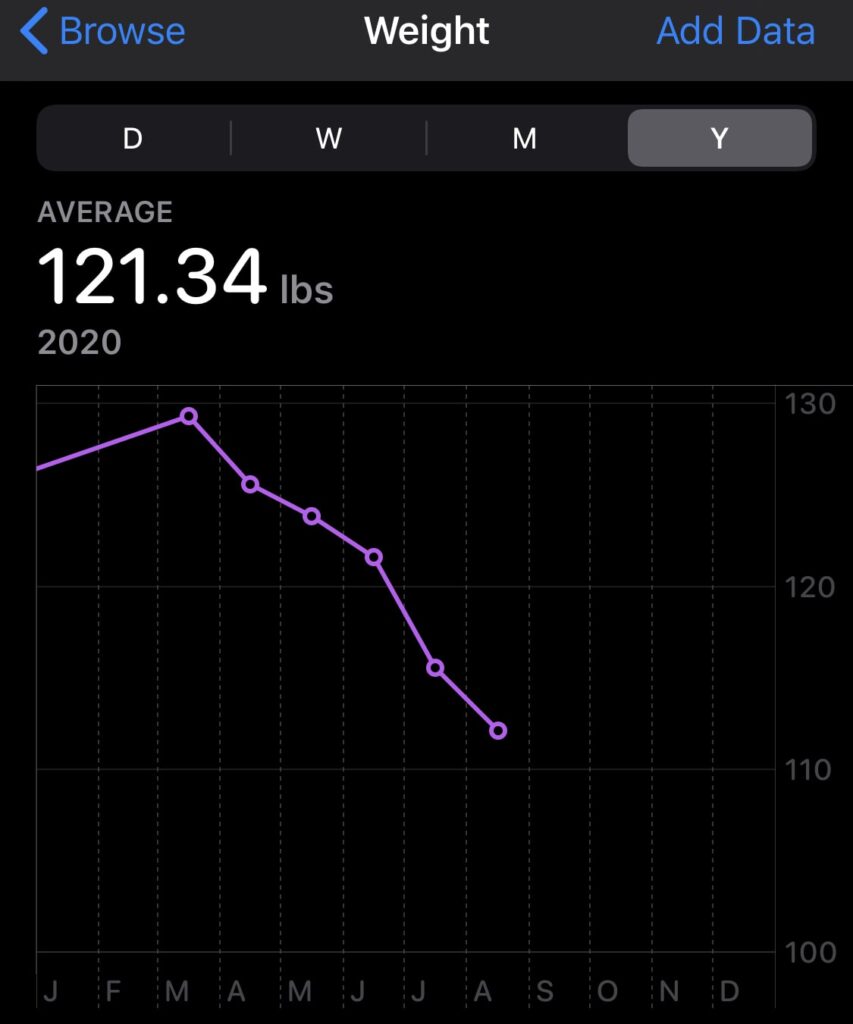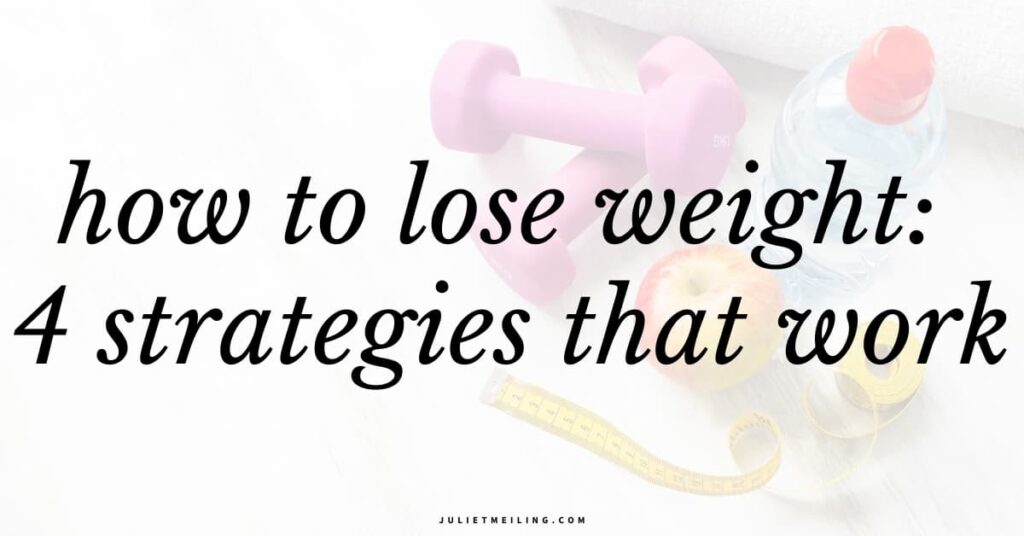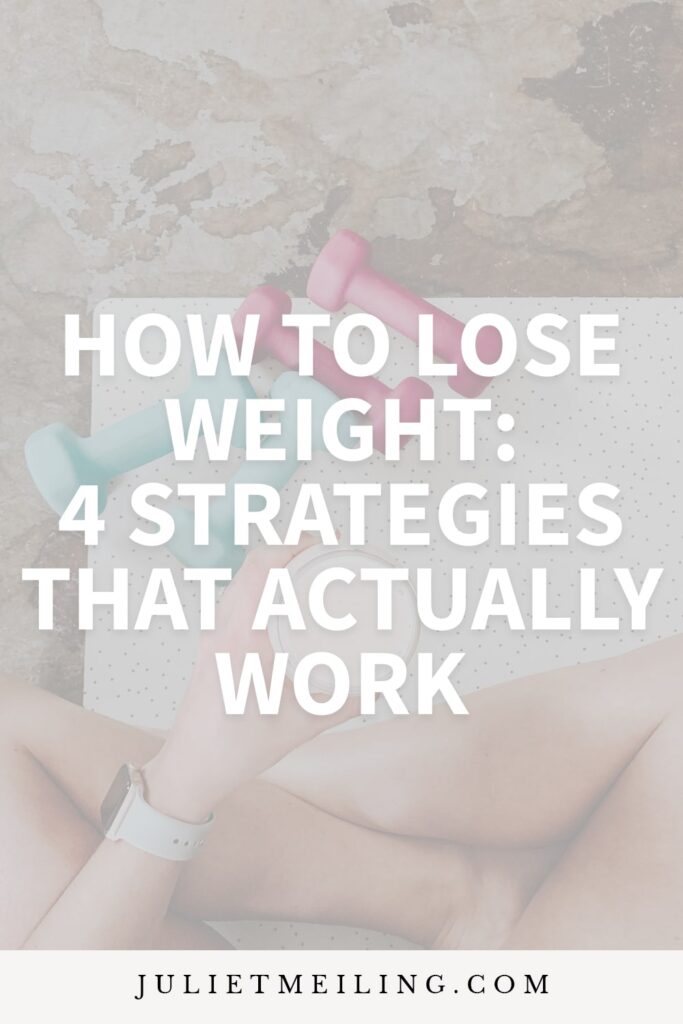How to Lose Weight: 4 Strategies That Actually Work
Want to lose weight in a healthy, strategic manner? Implement these 4 strategies to lose weight.
Are you looking to lose weight, but are unsure how to make it happen? Or maybe you tried what seems to be every weight loss strategy in the book, but none of them have worked?
In March 2020 I weighed myself in at 130 lb.

I was shocked by the number on the scale due to the fact that I am a petite Asian woman standing at only 5 ft tall.
I wasn’t sure what went wrong: Was I eating too much? Was I not exercising enough? Was this just the last bit of puberty hitting me? At one point I was blaming my birth control for my weight gain and switched my birth control from Sprintec to Junel Fe.
It turns out my weight gain was not from my birth control or late-onset puberty. It was overeating–constantly being in a calorie surplus–and not exercising enough.
I was crushed, I had low self-confidence, and I didn’t feel comfortable in my own skin. I started to pity myself and I desperately wanted to go back to my senior year of college where it seemed like I had it all together…
Instead of dwelling too long and being exhausted from loathing myself, I decided to retake control over my body, and in 5 months I have gone from 130 lb. to 110 lb.
In today’s blog post I am sharing with you how to lose weight and the 4 exact strategies that actually helped me lose weight. I absolutely can’t wait to share with you these weight loss tips in hopes that it will help you on your journey as well.
I was to preface this blog post by stating that: I am not a doctor or medical professional.
Medical Advice Warning: I am not able to diagnose or treat any medical problem(s) you may have. These weight loss tips I am sharing with you in this blog post are from my personal experience and they may not work for you or could be potentially harmful to you. If you are having difficulty losing weight please consult with your doctor or medical professional.
Trigger Warning: In this blog post, we discuss topics (weight loss, calorie counting, food tracking, etc.) that may be sensitive or triggering to individuals who have suffered from or are currently suffering from an eating disorder(s).
Finally, remember that a number on the scale does not define you. How you feel about yourself and your body is more important than a number on the scale.
- Want to lose weight in a healthy, strategic manner? Implement these 4 strategies to lose weight.
- Strategy #1: Find a method of exercise you love
- Strategy #2: Incorporate cardio and strength training
- Strategy #3: Track your food and create a calorie deficit
- Strategy #4: Consistency is key
- In conclusion on how to lose weight
- Thanks for reading about how to lose weight for beginners.

*This post may contain affiliate links. Purchasing a product or service through an affiliate will earn me a small commission at no additional cost to you. Please read our Disclaimer Policy for more information about the use of affiliate links on this site.
Strategy #1: Find a method of exercise you love
If you want to lose weight it is not going to happen by sitting on the couch and watching Netflix (I’m sorry, I wish it could!!). To lose weight you need to get your body moving.
However, actually getting your body to move off of the couch and onto a treadmill or to the gym is challenging. For some people, it just doesn’t sound very appealing and for some, it sounds even scary.
One of the best ways to kickstart your weight loss journey is to just explore different ways to exercise. Exercise is not black and white or just cardio or strength training.
There are a ton of ways to exercise that you can fall in love with!
Here are some to consider:
- Yoga
- Pilates
- Cycling
- Swimming
- Kick boxing
- Jump roping
- Zumba
- Running (short or long distance)
- High intensity interval training
- Strength training
- Circuit training
- Cross training
If you are nervous about trying out a new way to exercise, you can always try it at home first by searching for a video on YouTube.
I absolutely love YouTube workout videos because they are free, you can do them whenever, and some fitness YouTubers include modified movements for those who need them. I’ll be talking about some fitness gurus on YouTube to watch later in this post, so keep on reading to find out!
I personally fell in love with running. Even though it is challenging, I like how running makes me feel accomplished and mentally clear afterward. Its the only type of exercise I come back to time and time again.
Related: How to Start Running for Beginners – 7 Tips for Beginners
Ultimately, your goal is to find a way to exercise that you love, can commit to, and that makes you feel amazing afterwards! One of the easiest ways to halt your weight loss journey is to stop being active. So it is essential that you find something you love!
Strategy #2: Incorporate cardio and strength training
Finding a type of exercise you love is a great way to get into the habit of working out. And I truly recommend you finding something you love to do even when you are all out of motivation to work out.
However, if you want to start seeing results you need to incorporate both cardio and strength training.
At the beginning of my weight loss journey in March 2020 I was only running. And my results were barely noticeable.
I was not seeing any physical changes to my body even though I was running about 3-4 times a week. It was not until May 2020 when I started incorporating both cardio and strength training that I started noticing physical changes in my body.
With strength training, I noticed my whole entire body toning up starting with my legs, then my back, then arms, and finally my stomach. And with cardio, I noticed that I was able to breathe better during my workouts and have the mental toughness to endure my workouts.
Cardio and strength training are seriously the dream team when it comes to weight loss. Why? Let’s break it down.
Cardio
Cardio is your heart health’s BFF and can help you burn some serious calories. There are different types of cardio, so take some time to discover your favorite and stick with it!
Weight Watchers blog post, 7 Types of Basic Cardio Workouts, lists the following cardio types:
- Circuit training
- High-intensity interval training (HIIT)
- Kettlebell training
- Non-impact
- Sprinting or speed work
- Steady state cardio
- Tabata
Personally, I have tried HIIT, steady state cardio (running), and tabata. Steady-state cardio always remains the top contender for me and I consistently run at least a 5k twice a week and a 10k once a week.
However, if you hate steady-state cardio or don’t have enough time in the day to run for 30-minutes to an hour, try another type of cardio. HIIT or Tabata is great because you don’t have to commit as much time to it, you get your heart pumping, and you can burn a lot of calories too!
There are a ton of HIIT workouts on YouTube and Instagram you can try out and fall in love with. If you need a starting place, try this 10 minute HIIT workout video by Chloe Ting or this 20-minute low-impact HIIT video from MadFit (Maddie Lymburner).
The downside to just doing cardio
Cardio is a great weight loss strategy–it’s free, easily doable for most people, and you can do it anywhere–especially if you are starting to lose weight and trying to create a routine for yourself. Among the many benefits of cardio such as making your heart healthier and stronger and building mental toughness, and it feels pretty dang awesome finishing a run.
However, cardio by itself is not going to cut it if you want to lose weight and get your body to reflect all the hard work you are putting in day in and day out.
Focusing only on cardio can also prevent you from reaching your weight loss goals because your body adapts to the cardio workouts, and thus, you burn fewer calories over time. It can also lead to injury because of the repetitiveness of it.
When I started my weight loss journey in March 2020, I did not see my body change dramatically until I incorporated strength training (and calorie tracking–more on that later).
From March 8, 2020 (129.3 lb.) to May 30, 2020 (123.7 lb.) I had lost weight, but I was still “skinny-fat”. That meant that although I was at a healthy weight, I had more fat than muscle on me, especially in the lower abdomen area.
At the start of June, I corporated strength training. At the time I weighed 125.8 lb. (June 1, 2020) and by the end of June, I was 118.1 lb. (June 30, 2020).
Truthfully, for you to meet your weight loss goals and body goals you need to do more than cardio. And that is where strength training comes into play!
Strength training
Adding strength training into your fitness routine will elevate your weight loss journey by helping you create and shape the body you desire through building muscle. However, I know the term, “building muscle,” can sound intimidating. When you think of muscles you think of a big buff dude at the gym. Let’s clear one thing up:
Building muscle does not mean you will look buff or overly muscular. Without being too technical, strength training will help you burn more fat and replace the fat you burned with lean muscle.
As a result, your muscle growth, or gains, will help you burn fat faster and boost your metabolism. This cycle of building muscle, burning fat, metabolism boost will ultimately help you reach your weight loss goals faster than just cardio because you’ll be able to burn more calories when you aren’t working out.
It’s like making passive income, but with your body and you are burning calories instead of earning money. And I definitely would rather burn calories than money!
Strength training can also be more time savvy than cardio. Your strength training sessions do not have to be as long as your cardio sessions to see results. You also–at least I don’t–sweat like a maniac during strength training, so that’s an extra bonus!
How to implement strength training as a weight-loss strategy
Strength training does not have to consume your life for you to start seeing changes in your body. In fact, at a minimum, you only need to do strength training twice a week for it to be effective!
If you are only strength training twice a week, you’ll need to do full-body strength training in order to work out both your upper and lower body muscles. If you are able to strength train more than twice a week, you can split your workouts into lower and upper body days.
Healthline provides an excellent how-to-guide on structuring your workouts throughout the week and their weekly plan includes a mix of cardio days and strength training days.
Personally, I strength train at least twice a week, for 30 minutes each strength training session.
My workout schedule typically looks like this:
Monday: Rest day
Tuesday: Run a 5k
Wednesday: Strength train
Thursday: Run a 5k
Friday: Strength train
Saturday: Run a 10k
Sunday: Rest
Whenever I strength train I typically following an Instagram workout.
Currently I am loving workouts from:
Strategy #3: Track your food and create a calorie deficit
Exercise and being active is not the only thing you need to incorporate to lose weight. There is a saying that weight loss is 80% what you eat and 20% exercise. And it’s so true! Sadly…
In order to lose weight you really need to get serious about tracking your food, choosing foods that nurture your body, and creating a calorie deficit for your body.
What is a calorie deficit?
In layman’s terms, a calorie deficit is when you intake or eat fewer calories than you burn. Creating and being in a calorie deficit, over time, results in weight loss.
Now don’t worry, you don’t have to exercise like a manic to be in a calorie deficit because your body naturally burns calories at “rest” doing the day-to-day functions, like breathing and keeping your heart beating, that keeps you alive.
You also burn calories when your body is processing the food you have eaten and, of course, when you exercise.
If you are able to remain in a calorie deficit long enough–we’re talking months–you will lose weight. Alternatively, if you burn less calories than you eat, you end up in a calorie excess, and as a result, gain weight.
Personally, it took me being in a calorie deficit for almost 5 months to go from 130 lb. to 113 lb., so don’t expect results over night!
Do I have to be in a calorie deficit if I exercise?
A resounding YES, you need to be in a calorie deficit even if you exercise because exercising alone may not put you in a calorie deficit.
In fact, you may end up in a calorie excess phrase or eating at maintenance (meaning you are eating the number of calories to maintain your current weight) because of what you eat after you work out.
After you work out or a little while after, you are most likely going to be HUNGRY. If you don’t watch what you are eating and just think, “I ran 5 miles, I can eat all the pizza I want and not gain weight,” then you are practically throwing all your hard work out the window.
You need to remain in a calorie deficit if you want to see any movement on the scale and changes to your body physically. So I highly recommend tracking your food in order to achieve your weight loss goals.
Tools to track your food and help you create a calorie deficit
Tracking your food is the best way to know if you are putting your body into a calorie deficit. Not tracking your food is like driving to a new place with no GPS: it’s going to take a while for you to get to your destination.
To track your calories you’ll need two things–and we will talk about both in this post:
- Calorie counting app
- Food scale
Calorie counting app
The easiest way to track your food is with My Fitness Pal.
My Fitness Pal is a free mobile app (there is a premium version, but I don’t think it’s very necessary) that will calculate how many calories you need to eat per day in order to be in a calorie deficit.
My Fitness Pal will take into account your:
- Current/starting weight
- Activity level–not very active, lightly active, active, and very active
- Goal weight
- How many pounds you want to lose per week–0.5 lb./week to 2 lb./week
Food scale
In addition to My Fitness Pal, you will need a food scale.
Personally, I did not buy a food scale until 4 months (July 2020) into my weight loss journey, and by then, I had already lost 12 lb. (130 lb. to 118 lb.).
However, I bought a food scale because I knew a food scale would help me accurately measure my food, especially the food that you can’t easily measure like fruit. Since I bought my food scale and started using it, I have lost 5 lb. in one month (118 lb. to 113 lb.).
How to track your food using My Fitness Pal
Tracking your food is really easy when you use a calorie tracking app. My Fitness Pal claims to have a database of 11 million foods, which makes it easy to simply search or scan for the item that you are eating.
Personally, I like scanning the barcode on food packages to get the exact item I am looking for, but I always double-check the nutritional values before I record it into the app.
My Fitness Pal allows you to track calories by meal–breakfast, lunch, dinner, and snacks–so you can see where your calories are being spent throughout the day.
To enter in food you have eaten:
- Open the app and press the blue “+” button at the bottom of the screen
- Select “food”
- Select what meal of the day you are entering for
- Search for the food in the search bar or use the barcode scanner.
Once you have searched or used the bar scanner to find your food you can adjust the serving size you had or are planning to have.
How to track food that is hard to measure/track
Some food is harder to track than others like a meal at a restaurant or food that cannot be measured accurately with measuring cups–like fruit or peanut butter.
When it comes to restaurant food, I would try to look up the item on the restaurant’s website and see if there is any calorie information on there. If not, try your best to estimate yourself by finding a related item in the My Fitness Pal database.
Because tracking restaurant food is so difficult, I tend to not eat out as much because I want to be as accurate as possible with my food tracking. So instead I make meals at home, which are just as delicious and it saves me money too!
For hard to measure food that I consume at home–like fruit, peanut butter, hummus, spinach, etc.–I use my food scale to tell me how many grams I am consuming and then adjust the serving size accordingly in My Fitness Pal.
What can I eat while on a calorie deficit?
The whole concept of a calorie deficit is that you are consuming fewer calories than you are burning. As long as you are doing that, you can pretty much eat whatever you want.
However, you need to be super careful because one of the first things you may realize while being on a calorie deficit is that calories get consumed fast!
Think of it as budgeting your money: while that exciting new paycheck is great at first and you feel super-rich, once you spend a majority of it on your monthly rent, insurance payments, grocery shopping, gas, etc. you are then holding onto every last dollar until the next paycheck.
The same analogy applies to tracking your food and the calories you consume. For example, if you consume too many calories at breakfast you won’t have enough calories you can consume at lunch or dinner. While this is frustrating, calorie counting can help you find a balance between all your meals.
I am still in a calorie deficit and plan to be in one until I hit my target goal of 110 lb.
My meals while trying to stay in a calorie deficit include foods that I love like carbs (pasta and bread), ice cream (Halo Top has 60-calorie ice cream pops), chocolate (usually consumed from the protein bars I eat), eggs, cheese, quesadillas, etc.
I also make breakfast and dinner my larger meals and have a lighter lunch to allow me to eat more in the morning and in the evening and not feel bogged down if I go work out after getting off of work.
Can I have cheat meals while in a calorie deficit?
Yes, you can certainly have cheat meals! Even though for weight loss to happen you need to be in a long-term calorie deficit, you don’t have to forgo cheat meals!
Having one cheat meal will not hinder your progress or instantly make you gain back the weight. Having a cheat meal can actually be rewarding and can prevent you from being burned out from maintaining a calorie deficit.
However, you need to be careful with cheat meals and not make a cheat meal into a cheat day or into a binge eating episode. Even with cheat meals, you need to be somewhat disciplined.
Personally, I have a cheat meal twice a week, one on Sunday and one on Monday, and it has not prevented me from meeting my health and fitness goals!
Strategy #4: Consistency is key
At the end of the day, no weight loss strategy is going to work if you are not consistent about it. In order to lose weight you need to be committed and be consistently working towards your health and fitness goals everyday.
Weight loss is a long-term game. It takes a lot of patient, time, energy, and belief in yourself that you can achieve your goals.
If you have a challenging time being consistent, try setting weekly goals or using a habit tracker and mark each day you work out or maintain a calorie deficit.
You could also find someone–like your significant other, family member, or friend–who can hold you accountable.
In conclusion on how to lose weight
Losing weight is challenging, and rightfully so. When you start the journey of losing weight you are changing not only the number that shows up on the scale, but also your entire lifestyle!
In today’s blog post I shared 4 strategies to help you lose weight. These 4 strategies not only will help you lose weight, but they will also help you lose weight in a healthy way.
In summary, to lose weight you need to implement these 4 weight loss strategies:
- Find a method of exercise you love
- Incorporate both cardio and strength training
- Track your food
- Stay consistent
Save this blog post to read or refer back to later by clicking the Pinterest share button below this image.







